Dene Kedǝ to Dene Ts'ı̨lı̨ (1st ed) Appendix D: Speakers and Learners–Data Collection on Language, Practice, and Ideology in the Sahtú
This document is one of six appendices from the first iteration of the report From Dene Kedǝ to Dene Ts’ı̨lı̨: Rethinking Resurgence in the Sahtú Region. In it, the team provides a basic historical review of some of the data collected about Dene language speakers and learners in the Sahtú, along with figures on land use, subsistence, and arts. It also includes some qualitative data about Sahtú perceptions or ideologies of language and revitalization.
About the project:
From Dene Kedǝ to Dene Ts’ı̨lı̨ is a collaborative project that explores lessons learned through the past fifty years of Dene and Métis language and way of life initiatives. Bringing together knowledge and experience from longtime activists and educators and youth, as well as review of over 275 documents, the aim is to create a resource for decision-makers and researchers as a basis for resurgence in the Sahtú Region. All phases of this project involve a dialogue between today’s initiatives and yesterday’s legacy.
The picture that has emerged is complex, involving at least seven domains of resurgence: speakers and learners; local knowledge; documentation; education; media; law and policy; and ways of life. During this project we saw the emergence of exciting projects like the Dene Ts’ı̨lı̨ School, a cross-cultural on the land learning opportunity for youth. This school became an integral part of the research and learning process.
Read more about From Dene Kedǝ to Dene Ts’ı̨lı̨. Download the appendix using the PDF link at the bottom of this page.
Cite this resource:
"Appendix D - Speakers and Learners–Data Collection on Language, Practice, and Ideology in the Sahtú" in Faun Rice, Keren Rice, Deborah Simmons, Walter Bezha, Jordan Lennie, Shelby Lennie, Michael Neyelle. From Dene Kedǝ to Dene Ts’ı̨ lı̨: Rethinking Resurgence in the Sahtú Region, Northwest Territories©Ɂehdzo Got’ı̨ nę Gots’é ̨ Nákedı (Sahtú Renewable Resources Board), Tulı́ t'a, Northwest Territories, www.srrb.nt.ca. October 2017 Edition.
Dene Kedǝ to Dene Ts'ı̨lı̨ (1st ed) Appendix E: Timeline of Dene Kedǝ and Dene Ts’ı̨lı̨ Events
This document is one of six appendices from the first iteration of the report From Dene Kedǝ to Dene Ts’ı̨lı̨: Rethinking Resurgence in the Sahtú Region. In it, the team provides a timeline of selected events and projects throughout Sahtú history, contextualized by events in the Northwest Territories and in Canada.
About the project:
From Dene Kedǝ to Dene Ts’ı̨lı̨ is a collaborative project that explores lessons learned through the past fifty years of Dene and Métis language and way of life initiatives. Bringing together knowledge and experience from longtime activists and educators and youth, as well as review of over 275 documents, the aim is to create a resource for decision-makers and researchers as a basis for resurgence in the Sahtú Region. All phases of this project involve a dialogue between today’s initiatives and yesterday’s legacy.
The picture that has emerged is complex, involving at least seven domains of resurgence: speakers and learners; local knowledge; documentation; education; media; law and policy; and ways of life. During this project we saw the emergence of exciting projects like the Dene Ts’ı̨lı̨ School, a cross-cultural on the land learning opportunity for youth. This school became an integral part of the research and learning process.
Read more about From Dene Kedǝ to Dene Ts’ı̨lı̨. Download the appendix using the PDF link at the bottom of this page.
Cite this resource:
"Appendix E - Timeline of Dene Kedǝ and Dene Ts’ı̨lı̨ Events" in Faun Rice, Keren Rice, Deborah Simmons, Walter Bezha, Jordan Lennie, Shelby Lennie, Michael Neyelle. From Dene Kedǝ to Dene Ts’ı̨ lı̨: Rethinking Resurgence in the Sahtú Region, Northwest Territories©Ɂehdzo Got’ı̨ nę Gots’é ̨ Nákedı (Sahtú Renewable Resources Board), Tulı́ t'a, Northwest Territories, www.srrb.nt.ca. October 2017 Edition.
Dene Kedǝ to Dene Ts'ı̨lı̨ (1st ed) Appendix B: Co-Author Reflections
This document is one of six appendices from the first iteration of the report From Dene Kedǝ to Dene Ts’ı̨lı̨: Rethinking Resurgence in the Sahtú Region. In it, Sahtú Dene and Métis co-authors reflect on their lived experiences and share stories that provide important human context for the history outlined in the report.
About the project:
From Dene Kedǝ to Dene Ts’ı̨lı̨ is a collaborative project that explores lessons learned through the past fifty years of Dene and Métis language and way of life initiatives. Bringing together knowledge and experience from longtime activists and educators and youth, as well as review of over 275 documents, the aim is to create a resource for decision-makers and researchers as a basis for resurgence in the Sahtú Region. All phases of this project involve a dialogue between today’s initiatives and yesterday’s legacy.
The picture that has emerged is complex, involving at least seven domains of resurgence: speakers and learners; local knowledge; documentation; education; media; law and policy; and ways of life. During this project we saw the emergence of exciting projects like the Dene Ts’ı̨lı̨ School, a cross-cultural on the land learning opportunity for youth. This school became an integral part of the research and learning process.
Read more about From Dene Kedǝ to Dene Ts’ı̨lı̨. Download the appendix using the PDF link at the bottom of this page.
Cite this resource:
"Appendix B - Co-Author Reflections" in Faun Rice, Keren Rice, Deborah Simmons, Walter Bezha, Jordan Lennie, Shelby Lennie, Michael Neyelle. From Dene Kedǝ to Dene Ts’ı̨ lı̨: Rethinking Resurgence in the Sahtú Region, Northwest Territories ©Ɂehdzo Got’ı̨ nę Gots’é ̨ Nákedı (Sahtú Renewable Resources Board), Tulı́ t'a, Northwest Territories, www.srrb.nt.ca. October 2017 Edition.
Indigenous Linguistics and Land Claims: The Semiotic Projection of Athabaskan Directionals in Elijah Smith's Radio Work.
The authors discuss a 1985 Southern Tutchone radio broadcast wherein co-performers used deitic spatial terms, placing a listener in relationship to the landscape being discussed, and “spatially evoking the history of the entire region.” (282). The authors contend that the linguistic features of radio performances such as these are linked to social uses and perceptions of place, including land claims and Indigenous rights to land.
Access this Resource:
Moore, Patrick and Daniel Tlen. “Indigenous Linguistics and Land Claims: The Semiotic Projection of Athabaskan Directionals in Elijah Smith's Radio Work.” Journal of Linguistic Anthropology 17, no. 2 (December 2007): 266-286.
Dene Godǝ - North Slavey Bibliography
This 20 page bibliography provides publication information, summaries, keywords, and images of book covers for Dene Kedǝ language and literacy resources. It appears to be organized very loosely by date of publication, ranging between 1979 and 2007. Original sources for a number of publications in the 1980s were the Black Lake First Nations, adapted for the Sahtu. A trend of the time to save on cost and effort was to use templates from other areas to develop materials.
Read more about Dene language learning resources by selecting the tags "language" or "education" on the left hand menu.
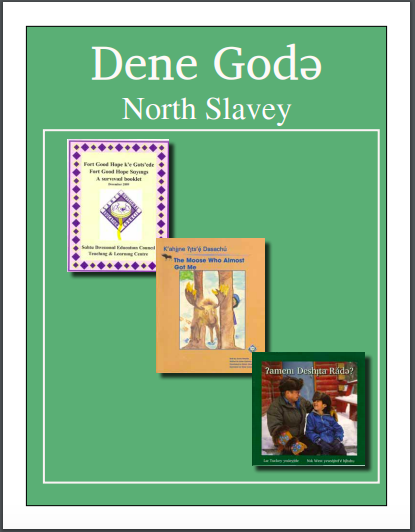
Access this Resource:
This resource is attached as a PDF below, and is also available on the SSDEC website.
Sahtú Divisional Education Council. Dene Godǝ - North Slavey Bibliography. Norman Wells: Sahtu Divisional Education Council, n.d.
Ɂetene Ɂǝhw’ı K’e – Dene Kádeɂá, Ɂelehé Yáts’erı́yǝ, Ɂelehé Dene Gáhuretę (On the Right Track)
This is a monolingual booklet about family activities. It may be a translation of a Saskatchewan Literary Network family literacy resource, adjusted by the NWT literacy council for northern languages. There is a foreword, where the text begins:
Menı gots’éráyı̨́dı máhsı héts’ǝdı. Hǝderı ɂedı̨htl’é ɂeyı Saskatchewan gots’ę ɂedı́tl’e hots’edúhsha gáɂeghálayeda keyá kıdeyı̨́tl’e. Wáyı júhad́ néné gogha ɂawót’e gha júhad́ ɂedı́tl’e gha dǝhw’ı ke rakıdeyı̨́tl’é. Júhad́ ɂedı́tl’é gha dǝ́hw’ı ke March 2002 gú ɂeyı júhad́ Government ɂeyı tsǫ́dane hı̨́delé gáhurútǝ̨́ gá ɂeghalayeda ke sǫ́ba hé gots’érákeyı̨́dǝ gháré hǝdǝrı ɂedı̨htl’é kedeyı̨́tl’e.
Read more materials from the Northwest Territories Literacy Network: https://www.nwtliteracy.ca/resources/indigenous-languages-and-literacies
Access this Resource:
Northwest Territories Literacy Council, Saskatchewan Literacy Network. Translated by Lucy Ann Yakelaya. Ɂetene Ɂǝhw’ı K’e – Dene Kádeɂá, Ɂelehé Yáts’erı́yǝ, Ɂelehé Dene Gáhuretę (On the Right Track), n.d.
Building Aboriginal Literacy Cards
These are a series of monolingual cards with photographs from Sahtú communities and Dene words. The introduction reads,
Dene xǝdǝ la begháré dene ts’ı̨lı̨ gha ket’ódeɁá yá ɂagóht’e. Dene xed́é k’égháré yá dene he’egúɂa, denewá ts’ı̨lı̨́ k’égháré ɂadegots’ǝdı hé ts’ı̨duwe légots’ede gháré dúle hı̨dówé gots’é bet’óts’edéhɂa. Menı begǫhlı̨ gots’é dene xǝdé k’é bet’sé gots’ǝdǝ nı́dé ɂeyı keyá dzı’ıne toréht’é kedexǝdǝ́ k’é denets’é gokǝdǝ gha.
Ts’ǫ́dane ke kugólı̨ gots’ę kugháı́ sóɂareht’e gots’é dúle t’áhsı̨ gołǫ kegokı́hɂa yá ɂakı̨t’e. Ɂeyı gháré dene hı̨sha ke hé menıdene xǝdǝ́ k’égodǝ ke ts’ǫ́dane ke kedexǝdǝ́ kúshu gha le’rakede.
Read more materials from the Northwest Territories Literacy Council: https://www.nwtliteracy.ca/resources/indigenous-languages-and-literacies
Access this Resource:
Northwest Territories Literacy Council. Building Aboriginal Literacy Cards, North Slavey. Yellowknife: Department of Education, Culture, and Employment, n.d.
Dene Sa Ɂerı̨ı̨htł’é
This text is a blank calendar with spaces to fill in the days anew each year. Illustrations and each month’s Dene name in both Dene and English mark each page, along with the days of the week in Dene language.
Ilı́gu zá, Edáedzeného zá January, Cold month, New Year’s month
Tłı̨chédé zá, Sa nek’ǫ́ne zá February, Dog wıggles hıs stıff taıl month, Short month
Det’ǫneho zá March, Month when eagle looks for food
Naeda zá Aprıl, Easter Month
Eghé zá May, Month when bırds lay theır eggs
Tsá kats’enı̨wę zá June, Beaver Huntıng Month
Įhbé July, Summer Month
Ek’a zá August, Month when anımals are fat
Egǫ́chı̨ ghǫ zá September, Moose huntıng month
Bek’e łue dats’ehté zá October, Month for storıng fısh
Ɂehdzo zá November, Trappıng Month
To yatı̨ zá December, Month of Chrıstmas
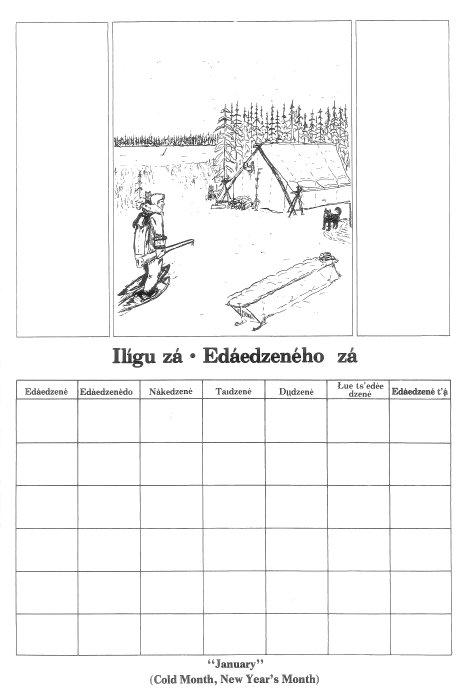
Access this Resource:
Available from the Ɂehdzo Got’ı̨nę Gots’ę́ Nákedı archives. Contact This email address is being protected from spambots. You need JavaScript enabled to view it. for access and see the Release and User Agreement form on the database home page.
Fort Franklin Slavey Language Program. Dene Sa Ɂerı̨ı̨htł’é. Northwest Territories Department of Education and Chief Jimmy Soldat School, n.d.
North Slavey Grow Chart, Kereyǝ Hé Gokǝdǝ Kéɂets’ı́hdz’a
This is a monolingual growth chart with cm measurements for different heights of children and corresponding images of different age groups learning to talk. For example, the baby at the bottom says, “Dúle duká ɂadehsı̨ (oo, goo, bababa)"
Read more resources from the Northwest Territories Literacy Council: https://www.nwtliteracy.ca/resources/indigenous-languages-and-literacies
Access this Resource:
Northwest Territories Literacy Council. “North Slavey Grow Chart, Kereyǝ Hé Gokǝdǝ Kéɂets’ı́hdz’a.” Family resource poster, n.d.
Official Languages Act
The Northwest Territories Official Languages Act outlines the legal protections afforded to Chipewyan, Cree, English, French, Gwich’in, Inuinnaqtun, Inuktitut, Inuvialuktun, North Slavey, South Slavey, and Tłįchǫ̨. This includes the ability to use Official Languages in government institutions (legislative proceedings, for example) and the appointment of a Languages Commissioner to ensure the implementation the Act. Additionally, the Act outlines the duties of a Minister for Official Languages, including implementation and annual evaluation of Official Language programs, and regional consultation in the form of an Official Languages Board and an Aboriginal Languages Revitalization Board with representatives from each language community.
Read about the history of different versions of the Official Languages Act.
Read the reports on Official Languages from the Languages Commissioner of the NWT.
The Government of the Northwest Territories makes Annual Reports on Official Languages from the last decade available here: https://www.ece.gov.nt.ca/en/services/francophone-affairs-secretariat/official-languages-annual-reports. Older reports are archived with the Department of Education, Culture, and Employment.
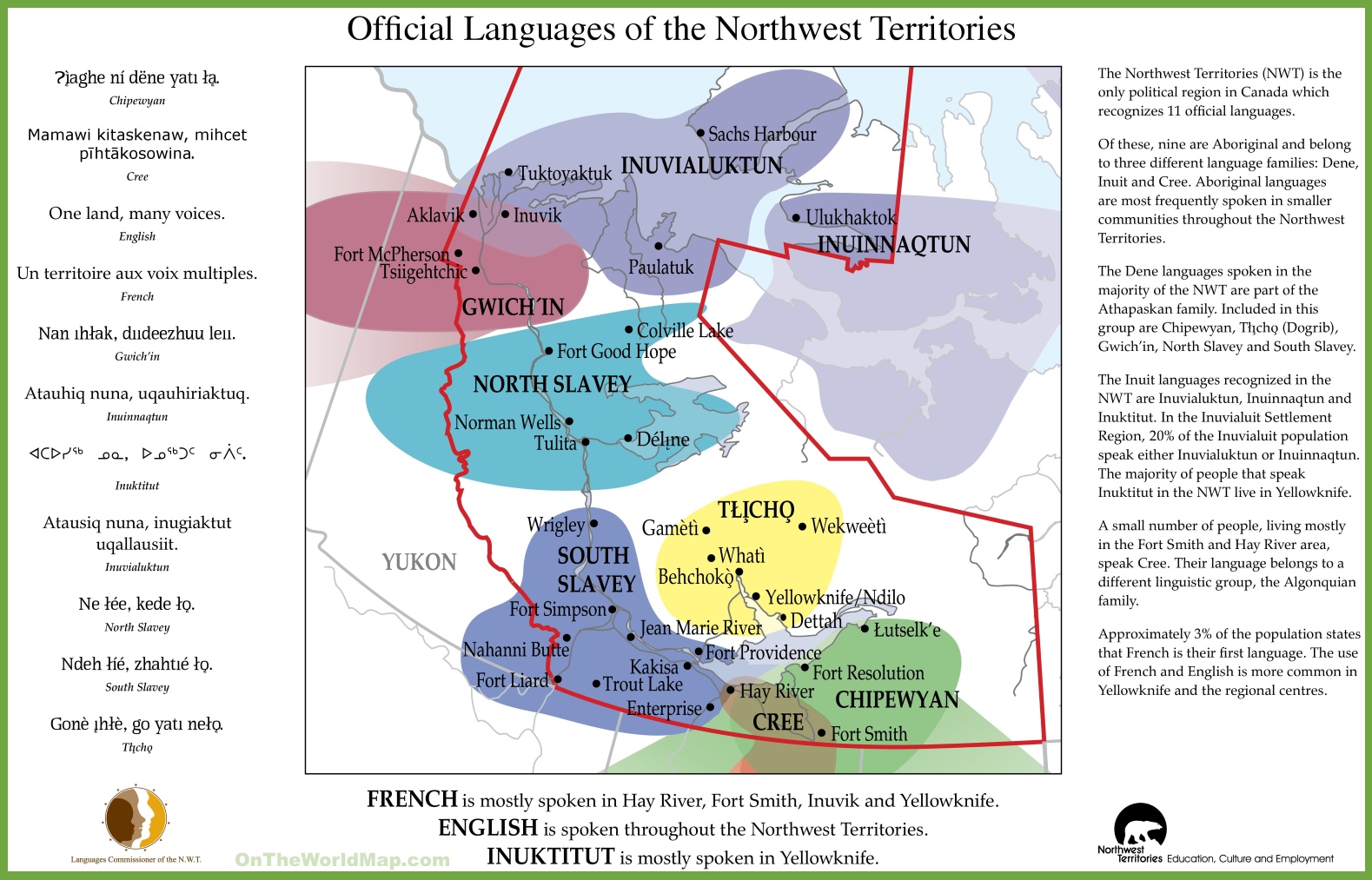
Access this Resource
Official Languages Act, R.S.N.W.T. c O-1, 1988.
The Act is available to read on the justice.gov.nt.ca website.


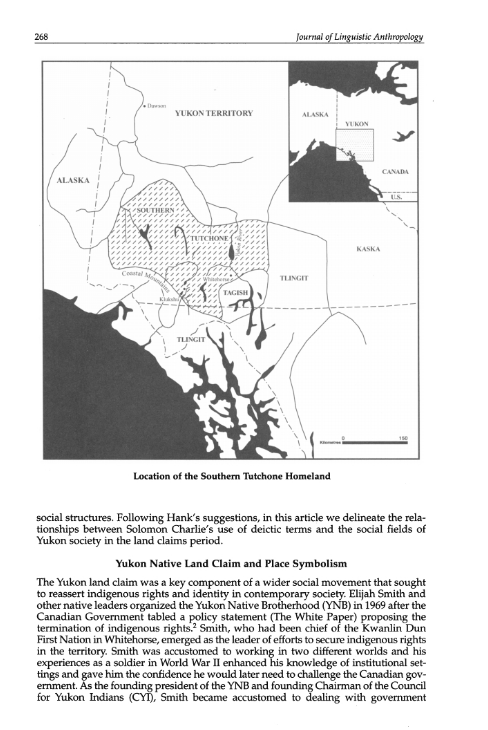
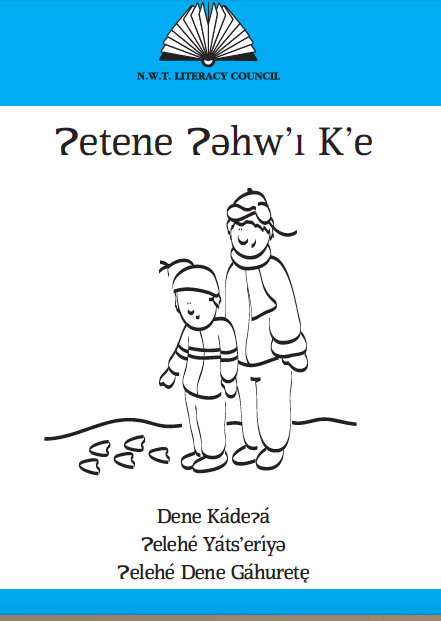
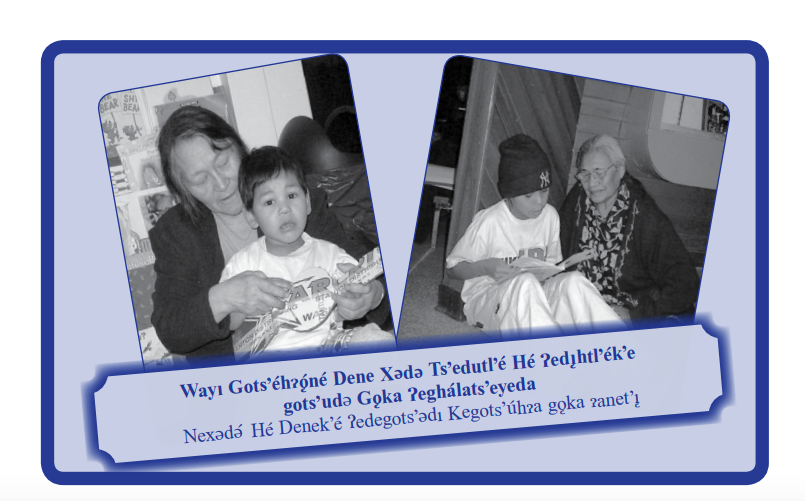
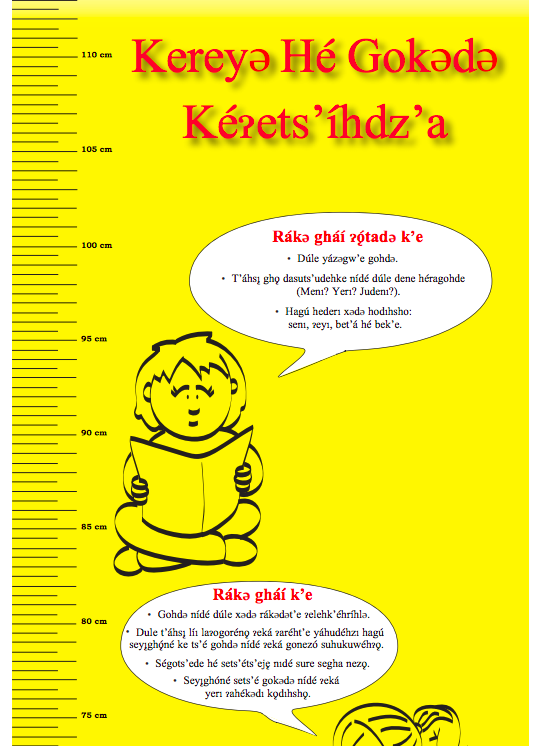
 Phone: 867-374-4040
Phone: 867-374-4040 Email:
Email: